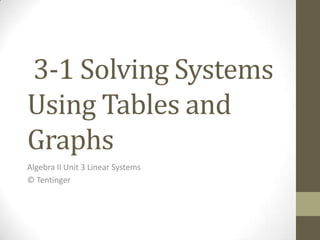
Alg II3-1 Solving Systems Using Tables & Graphs
- 1. 3-1 Solving Systems Using Tables and Graphs Algebra II Unit 3 Linear Systems © Tentinger
- 2. Essential Understanding and Objectives • Essential Understanding: to solve a system of equations, find a set of values that replace the variables in the equations and make each equation true. • Objectives: • Students will be able to solve linear system using a graph or table
- 3. Iowa Core Curriculum • Algebra • A. CED.2 Create equations in two or more variables to represent relationships between quantities; graph equations on coordinate axes with labels and scales. • A.CED.3 . Represent constraints by equations or inequalities, and by systems of equations and/or inequalities, and interpret solutions as viable or nonviable options in a modeling context. For example, represent inequalities describing nutritional and cost constraints on combinations of different foods. • A.REI.6 Solve systems of linear equations exactly and approximately (e.g., with graphs), focusing on pairs of linear equations in two variables. • A.REI.11 Explain why the x-coordinates of the points where the graphs of the equations y = f(x) and y = g(x) intersect are the solutions of the equation f(x) = g(x); find the solutions approximately, e.g., using technology to graph the functions, make tables of values, or find successive approximations. Include cases where f(x) and/or g(x) are linear, polynomial, rational, absolute value, exponential, and logarithmic functions.★
- 4. System of Equations • System of equations: when you have two or more related unknowns, you can represent them with a set of two or more equations. • Linear System: consists of linear equations • Solution of a System: the set of values for the variables that makes all the equations true. • There could be one solution • Infinitely many solutions • No Solution • You can use a graph or table to solve a system of equations
- 5. What is the solution? • Two different methods to solve: • Graphing • Table ì y = -x + 3 ì x - 2y = 4 ï í í 3 î3x + y = 5 ïy = x - 2 î 2 ì3x + y = 5 í îx - y = 7
- 6. Example • If the growth rates • Greenland Shark continue, how long will Growth Rate: 0.75 cm/yr each shark be when it Birth Length: 37 cm is 25 years old? • Spiny Dogfish Shark • Explain why growth Growth Rate: 1.5 cm/yr rates for these sharks Birth Length: 22 cm may not continue indefinitely. • If the growth rates stayed the same at what age would the two sharks be the same length?
- 7. Example • The table shows the populations of San Diego and Detroit. • Assuming the trends continue, when will the population of these cities be equal? What will the population be? • Step 1: Enter the Data into your lists on your calc • L1: Number of Years since 1950 • L2: San Diego population • L3: Detroit Population • Step 2: In the Stat Plot, turn on plots 1 and 2. In Plot 2 change list L2 to L3 by using the 2nd 3 (L3) to get the L3 list. Adjust window 1950 1960 1970 1980 1990 2000 San Diego 334,387 573,224 696,769 875,538 1,110,549 1,223,400 Detroit 1,849,568 1,670,144 1,511,482 1,203,339 1,027,974 951,270
- 8. Example • The table shows the populations of San Diego and Detroit. • Assuming the trends continue, when will the population of these cities be equal? What will the population be? • Step 3: Calc the LinReg for both populations (you will need to type information into L2) • San Diego:17816x + 356896 • Detroit: -19217x + 1849401 • Step 4: Calculate intersection of the lines • Answer: 1990 and about 1,074,917 1950 1960 1970 1980 1990 2000 San Diego 334,387 573,224 696,769 875,538 1,110,549 1,223,400 Detroit 1,849,568 1,670,144 1,511,482 1,203,339 1,027,974 951,270
- 9. Classifying a System of two Linear Equations • Independent System: has one solution • Independent • 2 lines intersect at one point • the slopes of the lines are not equal • the y-intercepts may or may not be equal • Dependent System: has infinitely many solutions • Dependent • 2 lines coincide • the slopes of the lines are equal • the y-intercepts are equal • Inconsistent System: No Solution • Inconsistent • 2 parallel lines • the slopes of the lines are equal • the y-intercepts are not equal
- 10. Example • Without graphing, is the system independent, dependent, or inconsistent? ì-3x + y = 4 ï í 1 ïx - y = 1 î 3 ì2x + 3y = 1 í î 4x + y = -3 ì y = 2x - 3 í î6x - 3y = 9
- 11. Homework • Pg. 138 – 139 • #2 – 40 even • 19 problems